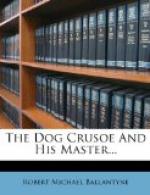There was a cry of horror, and at the same moment a volley was fired at the bear’s head; for the trappers felt that it was better to risk shooting their comrades than see them killed before their eyes. Fortunately the bullets took effect, and tumbled him over at once without doing damage to either of the men, although several of the balls just grazed Henri’s temple and carried off his cap.
Although uninjured by the shot, the poor Iroquois had not escaped scathless from the paw of the bear. His scalp was torn almost off, and hung down over his eyes, while blood streamed down his face. He was conveyed by his comrades to the camp, where he lay two days in a state of insensibility, at the end of which time he revived and recovered daily. Afterwards when the camp moved he had to be carried; but in the course of two months he was as well as ever, and quite as fond of bear-hunting!
Among other trophies of this hunt there were two deer and a buffalo, which last had probably strayed from the herd. Four or five Iroquois were round this animal whetting their knives for the purpose of cutting it up when Henri passed, so he turned aside to watch them perform the operation, quite regardless of the fact that his neck and face were covered with blood which flowed from one or two small punctures made by the bear.
The Indians began by taking off the skin, which certainly did not occupy them more than five minutes. Then they cut up the meat and made a pack of it, and cut out the tongue, which is somewhat troublesome, as that member requires to be cut out from under the jaw of the animal, and not through the natural opening of the mouth. One of the fore legs was cut off at the knee joint, and this was used as a hammer with which to break the skull for the purpose of taking out the brains, these being used in the process of dressing and softening the animal’s skin. An axe would have been of advantage to break the skull, but in the hurry of rushing to the attack the Indians had forgotten their axes; so they adopted the common fashion of using the buffalo’s hoof as a hammer, the shank being the handle. The whole operation of flaying, cutting up, and packing the meat did not occupy more than twenty minutes. Before leaving the ground these expert butchers treated themselves to a little of the marrow and warm liver in a raw state!
Cameron and Joe walked up to the group while they were indulging in this little feast.
“Well, I’ve often seen that eaten, but I never could do it myself,” remarked the former. “No!” cried Joe in surprise; “now that’s oncommon cur’us. I’ve lived on raw liver an’ marrow-bones for two or three days at a time, when we wos chased by the Camanchee Injuns an’ didn’t dare to make a fire; an’ it’s ra’al good, it is. Won’t ye try it now?”
Cameron shook his head.
“No, thankee; I’ll not refuse when I can’t help it, but until then I’ll remain in happy ignorance of how good it is.”




